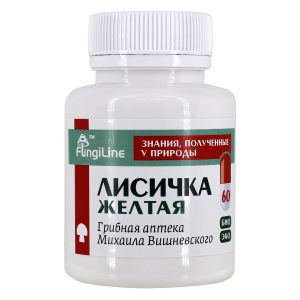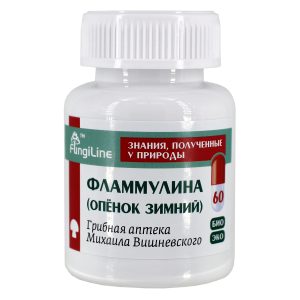White dung • 60 capsules
6000 ₸
White dung is highly effective as an immunomodulator, anti-cancer agent and glucose metabolism regulator. The mushroom contributes to the normal course of pregnancy and has an antiherontological effect. It is not an anti-alcohol remedy! White dung is a little—known and extremely underestimated medicinal mushroom. Hurry up to buy it before it gets more expensive. The mushroom has passed clinical trials.
- Immunomodulation
- Antioxidant activity
- Antidiabetic activity
- Powerful anti-cancer activity
- Antiherontological activity
- Neuroprotective properties
- Normalization of pregnancy
- Antibacterial and fungicidal activity
- IS NOT AN ANTI-ALCOHOLIC REMEDY!
White dung (Coprinus comatus) powder of fruit bodies
For the preparation of activated (frozen) fine powder, the fruit bodies of white dung (Coprinus comatus) collected in the Crimea were used. Mushrooms are dried at a temperature of 45-50 ° C, which ensures complete preservation of pharmacological qualities. The drug contains a full range of components: polysaccharides, glycoproteins, ergosterol, phytosteroids, triterpenoids, vitamins and other bioactive substances that provide maximum support for most body functions and a sustained therapeutic effect.
The course of white dung consists of 60 capsules of 0.4 g of fine powder in each and is designed for 10 days of preventive or general health intake. Capsules should be taken three times a day (simultaneously or in fractions; before, during or after meals – it does not matter). The optimal break between courses is two weeks. It does not conflict with other mushrooms and medicines.
If you have a current medical condition, are taking medication, are pregnant or breastfeeding, consult a healthcare professional or a fungotherapist before using this product.
Description
Pharmacological and medical properties
The fungus has pronounced anti-cancer, antioxidant, antibacterial, antifungal, hepatoprotective and antidiabetic activity. Recently, neuroprotective properties have also been recorded for it.
The extract from fresh mushrooms showed complete suppression of test sarcoma-180 and Ehrlich carcinoma. Compounds that stop the growth of breast cancer cell culture have been identified. Alcohol extracts, even in small doses, kill ovarian cancer cells and stop prostate cancer. The antibiotic coprinin contained in white dung is active against pathogenic molds, fungi and bacteria (Aspergillus niger, Candida albicans, Esherichia coli, Staphylococcus, Pseudomonas and Bacillus). The enzymatically obtained coprinol is active against many types of gram-positive bacteria resistant to most modern drugs. Data have been obtained that polysaccharides of white dung contribute to the work of the enzyme lysozyme produced by the body, which damages the cell wall of pathogenic bacteria.
Studies of the last decade have shown that dung preparations rich in vanadium reduce blood sugar levels and, accordingly, can be used as antidiabetic. Mushroom extract with vanadium reduces glucose levels (including adrenaline) stabilizes glycohemoglobin and increases overall glucose resistance. The isolated polysaccharide komatin also increases overall glucose resistance and lowers cholesterol and triglycerides. The aqueous extract of the deep mycelial culture of white dung showed high antioxidant activity. This is due to the presence of ergothionine, one of the fungal amino acids.
The lipids contained in white dung (represented mainly by unsaturated fatty acids) contribute to the stabilization of cholesterol levels in the blood and prevent the development of atherosclerosis. In Asian official medicine, dung is used as an adjunct in the treatment of diabetes. Chromium-enriched gel from fresh mushroom helps to reduce blood sugar levels.
Clinical experiments have shown that the mushroom is especially useful for improving the vital signs of the elderly and children, and also contributes to the normal development of the fetus during pregnancy. Regular consumption of white dung strengthens the immune system, increasing the nonspecific immunological response of the body.
Fungotherapy
In China, it is used to treat hemorrhoids (resorption of hemorrhoids) and normalize digestion (it is believed that white dung stimulates and stabilizes the gastrointestinal tract).
At home, the optimal use of dried white dung should be considered either simply cooking as part of various mushroom dishes (soups, broths, roasts, etc.), or in the form of an aqueous infusion in the proportion of 1 tablespoon of roughly ground fruit bodies per glass of boiling water, which is infused in a thermos for 2-3 hours. For a pronounced effect in all cases, regular, fairly long-term use is necessary (2-3 times a week for 3-6 months).
What serious read on topic
Karaman M, Tesanovic K, Novakovic A, et al. Coprinus comatus filtrate extract, a novel neuroprotective agent of natural origin [published online ahead of print, 2018 Nov 17]. Nat Prod Res. 2018;1-5. doi:10.1080/14786419.2018.1533831
Li B, Lu F, Suo X, Nan H, Li B. Antioxidant properties of cap and stipe from Coprinus comatus. Molecules. 2010;15(3):1473-1486. Published 2010 Mar 9. doi:10.3390/molecules15031473
Rouhana-Toubi A, Wasser SP, Fares F. The Shaggy Ink Cap Medicinal Mushroom, Coprinus comatus (Higher Basidiomycetes) Extract Induces Apoptosis in Ovarian Cancer Cells via Extrinsic and Intrinsic Apoptotic Pathways. Int J Med Mushrooms. 2015;17(12):1127-1136. doi:10.1615/intjmedmushrooms.v17.i12.20
Stojković D, Reis FS, Barros L, et al. Nutrients and non-nutrients composition and bioactivity of wild and cultivated Coprinus comatus (O.F.Müll.) Pers. Food Chem Toxicol. 2013;59:289-296. doi:10.1016/j.fct.2013.06.017
Tešanović K, Pejin B, Šibul F, et al. A comparative overview of antioxidative properties and phenolic profiles of different fungal origins: fruiting bodies and submerged cultures of Coprinus comatus and Coprinellus truncorum. J Food Sci Technol. 2017;54(2):430-438. doi:10.1007/s13197-016-2479-2
Xu N, Zhang T, Chen X, Zhang H, Wang R. Sheng Wu Gong Cheng Xue Bao. 2017;33(5):808-816. doi:10.13345/j.cjb.160440
Zhang P, Li K, Yang G, et al. Cytotoxic protein from the mushroom Coprinus comatus possesses a unique mode for glycan binding and specificity. Proc Natl Acad Sci U S A. 2017;114(34):8980-8985. doi:10.1073/pnas.1706894114
Zhao H, Li H, Lai Q, et al. Antioxidant and hepatoprotective activities of modified polysaccharides from Coprinus comatus in mice with alcohol-induced liver injury. Int J Biol Macromol. 2019;127:476-485. doi:10.1016/j.ijbiomac.2019.01.067
Zhao H, Zhang J, Liu X, Yang Q, Dong Y, Jia L. The antioxidant activities of alkalic-extractable polysaccharides from Coprinus comatus on alcohol-induced liver injury in mice. Sci Rep. 2018;8(1):11695. Published 2018 Aug 3. doi:10.1038/s41598-018-30104-6
Vishnevsky M. V. Medicinal mushrooms of Russia. Moscow: Prospect, 2017.





